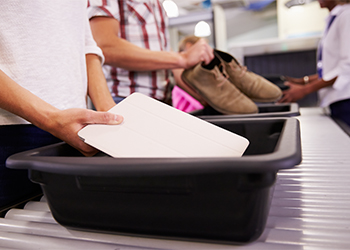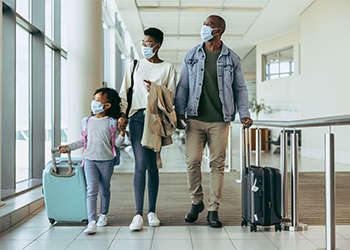Insights: Expecting Big Changes in the Terminal Environment

Major events or circumstances often make us reset our path. Over the years, the aviation industry has been transforming in response to events or service shifts, and it will continue evolving as new developments occur.
In its infancy, aviation was considered a luxury service, where people dressed up to travel, and flying was a lifetime experience. Airport terminals were simple, providing personalized check-in and bag check services, great looking lounges, and a simple place to retrieve bags.
As it evolved, travel became more accessible to all and international flights became more common. This new international connectivity required the introduction of governmental controls, and immigration and customs services appeared as a new layer in passenger processing.
During the 1960’s and 70’s, airlines started experiencing armed passengers hijacking airplanes, and diverting flights to countries such as Russia, Cuba and North Korea, in an attempt to reach political protection. There were also terrorism attacks that caused airplanes to explode in flight. These situations were painful and scary to travelers, and so, another function was introduced to terminal buildings: airports were forced to implement security check points, which were managed either by the airport or the airlines forbidding firearms or explosives to be carried into the airplane cabin.

Then events of 9/11 happened in the United States, and the airports suffered a major shift in the way they operate. The implementation of the Homeland Security Department in the US, and the introduction of TSA and CBP substantially modified terminal buildings functionality for both international and domestic processing. New regulations not allowing passengers without a visa connecting through the United States eliminated some terminal functions such as in-transit lounges, international lounges, and baggage screening. Heavy screening to baggage and passengers, now controlled by the government, established restrictions to passengers and airport workers affecting the way concessions and airlines operate.
Finally, in the last few years, the exponential developments in technology have triggered more changes to terminal functions, and passengers could bypass areas that they were obligated to go through before. Passengers can use their cell phones or personal computers to check in, and choose services such as Global Entry, TSA Pre-Check, or Mobile Pass to advance in the processing lines quickly.

Now, the aviation industry is facing another event that will monumentally change the methods of processing passengers. The World Health Organization declared Covid-19 a pandemic in March 2020. After that had such a paralyzing effect on the entire world, governments around the globe will attempt to identify health controlling methods at points of entry, so the proliferation of such viruses and diseases can be managed; airports, by nature, will be one of the first on the list.
Airports Council International (ACI) estimates that passenger traffic at airports could be reduced at least by 12% in the first quarter of 2020, with some airports down 80-90% at the end of March and early April 2020. The effect on flight cancellations and reduction in travel will impact airlines and airport operators drastically.
As terminal planners, we are obligated to work on solutions to improve passenger and baggage flows under the most current regulations and make suggestions on how to improve the travel experience to both the passenger and the operators. Our goal as terminal planners is providing innovative solutions to mitigate the effects of a reduction in the volume of passengers, and the implications of diminishing flights, concessions and parking activities. It is probable that large and medium size airports will experience entire concourses or large sections of facilities being dormant due to the reduction of passenger activity. For a period of time, airport operators may have to temporarily close facilities or zones to mitigate non-necessary building maintenance and operational costs.
Once this destabilization period has ended, the implementation of measures to control the spread of health hazards must begin. The implementation of infrared cameras with ambient compensation temperature allow to differentiate individuals who have normal temperatures from those with fevers using real time monitors with color and sound alarms. These detectors could be placed in both outbound or inbound corridors or queuing areas, so authorities would be able to identify sick travelers and proceed with more in-depth investigation or even isolation. Some airports in Asia are already implementing this technology into the existing metal detector devices with excellent results. Another idea is implementing disinfecting tunnels to sanitize equipment, baggage and even passengers through a mist of disinfectors that apparently work after a few seconds of exposure. China has set up these “disinfecting tunnels” that appear to be helping in the outbreak of the coronavirus.

Another essential service terminal planners offer is sizing the facility based on projections and square footage for levels of service. The current social distancing rules might significantly affect the calculations for queuing and processing elements at airport terminals. Perhaps, since some of the bacteria and viruses are airborne, changes to the HVAC systems should be addressed; for example, introducing methods of positive and negative pressure rooms or spaces as done in hospitals. Terminal planners, along with WHO, IATA and ICAO at the global level and TSA, CBP, and CDC at the domestic level, should work together to determine if our current area requirement standards are still valid, or if it’s necessary to modify and/or upgrade these standards.
In conclusion, we are facing another shake in the aviation industry. During and post the quarantine phases, terminal planners and airport operators will encounter immediate challenges responding to rapid facility transformation, so flexibility is key. We might be incorporating health controls and inspections, while being realistic and cost conscious. People still need and want to travel, life goes on, and we all need to adapt. Let’s learn from our experiences and keep contributing to a better and safer transportation world.
Miguel Carvajal
Associate Director, Terminal Planning
To learn more about C&S’s terminal planning capabilities, contact Miguel at mcarvajal@cscos.com, or (215) 399-4696.